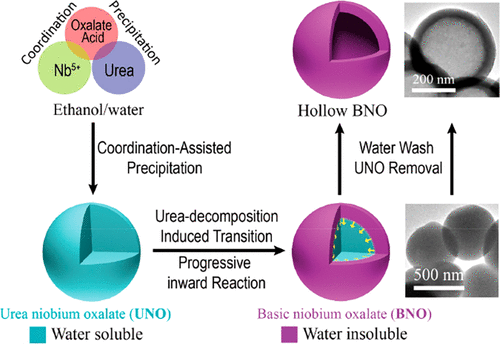当前位置:
X-MOL 学术
›
J. Am. Chem. Soc.
›
论文详情
Our official English website, www.x-mol.net, welcomes your
feedback! (Note: you will need to create a separate account there.)
Controlling the Reaction of Nanoparticles for Hollow Metal Oxides Nanostructures
Journal of the American Chemical Society ( IF 14.4 ) Pub Date : 2018-07-08 , DOI: 10.1021/jacs.8b04948 Yong-Gang Sun 1, 2 , Jun-Yu Piao 1, 2 , Lin-Lin Hu 1 , De-Shan Bin 1, 2 , Xi-Jie Lin 1, 2 , Shu-Yi Duan 1, 2 , An-Min Cao 1, 2 , Li-Jun Wan 1, 2
Journal of the American Chemical Society ( IF 14.4 ) Pub Date : 2018-07-08 , DOI: 10.1021/jacs.8b04948 Yong-Gang Sun 1, 2 , Jun-Yu Piao 1, 2 , Lin-Lin Hu 1 , De-Shan Bin 1, 2 , Xi-Jie Lin 1, 2 , Shu-Yi Duan 1, 2 , An-Min Cao 1, 2 , Li-Jun Wan 1, 2
Affiliation

|
Hollow nanostructures of metal oxides have found broad applications in different fields. Here, we reported a facile and versatile synthetic protocol to prepare hollow metal oxide nanospheres by modulating the chemical properties in solid nanoparticles. Our synthesis design starts with the precipitation of urea-containing metal oxalate, which is soluble in water but exists as solid nanospheres in ethanol. A controlled particle hydrolysis is achieved through the heating-induced urea decomposition, which transforms the particle composition in an outside-to-inside style: The reaction starts from the surface and then proceeds inward to gradually form a water-insoluble shell of basic metal oxalate. Such a reaction-induced solubility difference inside nanospheres becomes highly efficient to create a hollow structure through a simple water wash process. A following high temperature treatment forms hollow nanospheres of different metal oxides with structural features suited to their applications. For example, a high performance anode for Li-ion intercalation pseudocapacitor was demonstrated with the hollow and mesoporous Nb2O5 nanospheres.
中文翻译:

中空金属氧化物纳米结构的纳米粒子反应控制
金属氧化物的中空纳米结构在不同领域有广泛的应用。在这里,我们报告了一种通过调节固体纳米粒子的化学性质来制备空心金属氧化物纳米球的简便且通用的合成方案。我们的合成设计始于含尿素的金属草酸盐的沉淀,它可溶于水,但在乙醇中以固体纳米球的形式存在。通过加热诱导尿素分解实现受控颗粒水解,从而以由外到内的方式转变颗粒组成:反应从表面开始,然后向内进行,逐渐形成碱性金属草酸盐的不溶于水的壳. 这种反应引起的纳米球内部溶解度差异变得非常有效,可以通过简单的水洗过程创建中空结构。随后的高温处理形成具有适合其应用的结构特征的不同金属氧化物的中空纳米球。例如,用中空和介孔 Nb2O5 纳米球证明了锂离子插层赝电容器的高性能阳极。
更新日期:2018-07-08
中文翻译:

中空金属氧化物纳米结构的纳米粒子反应控制
金属氧化物的中空纳米结构在不同领域有广泛的应用。在这里,我们报告了一种通过调节固体纳米粒子的化学性质来制备空心金属氧化物纳米球的简便且通用的合成方案。我们的合成设计始于含尿素的金属草酸盐的沉淀,它可溶于水,但在乙醇中以固体纳米球的形式存在。通过加热诱导尿素分解实现受控颗粒水解,从而以由外到内的方式转变颗粒组成:反应从表面开始,然后向内进行,逐渐形成碱性金属草酸盐的不溶于水的壳. 这种反应引起的纳米球内部溶解度差异变得非常有效,可以通过简单的水洗过程创建中空结构。随后的高温处理形成具有适合其应用的结构特征的不同金属氧化物的中空纳米球。例如,用中空和介孔 Nb2O5 纳米球证明了锂离子插层赝电容器的高性能阳极。











































 京公网安备 11010802027423号
京公网安备 11010802027423号